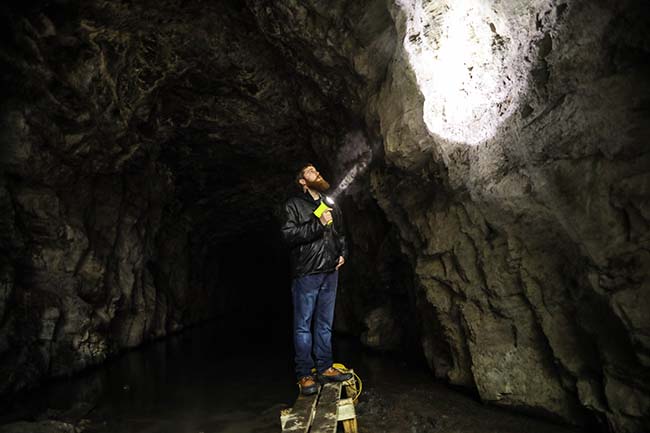

KENNESAW, Ga. | Jun 23, 2020

Kennesaw State assistant professor of microbiology Chris Cornelison has earned two research grants totaling more than $300,000 over the next two years—one from the U.S. Fish and Wildlife Service and another from the National Fish and Wildlife Foundation (NFWF) —to address how to mitigate the spread of white-nose syndrome, a fungal disease causing the rapid decline of tri-colored bats.
“These awards are critical to us being able to follow up on previous studies we have done, and we are incredibly grateful to have this opportunity,” said Cornelison, also the director of the BioInnovation Lab at KSU. “We are also able to support graduate research assistants, thanks to these awards, which is always critical to keeping the pipeline of talented students coming through KSU.”
Jeremy Coleman of the U.S. Fish and Wildlife Service touted the work of Cornelison, who has studied white-nose syndrome for several years.
”The projects that Chris Cornelison and partners are engaged in exemplify the critical work that is important for managing white-nose syndrome,” said Coleman, national white-nose syndrome coordinator for the U.S. Fish and Wildlife Service, which leads the national response to the disease. ”The Service is committed to improving survival of susceptible bat species and supporting research to understand and mitigate the effects of the disease on native bats.”
The grant from the U.S. Fish and Wildlife Service totals more than $200,000 for research on bat recovery from white-nose syndrome. KSU was one of 20 institutions nationwide to apply for this competitive funding opportunity of the White-Nose Syndrome Research Grant Program, which is administered by the FWS Wildlife and Sport Fish Restoration Program.

The project will focus on studying winter activity of the tri-colored bats in both traditional and non-traditional hibernaculum (culverts and bridges) in the southeastern U.S., pertaining to the susceptibility to white-nose syndrome. Fur and tissue samples will also be tested to determine population connectivity, which can be used to investigate the bats’ migratory range and help establish a pattern of disease transmission.
White-nose syndrome, which appears as a white powdery substance on bats’ muzzles, is caused by a fungus that invades and deteriorates the delicate skin of hibernating bats, including their wings. This disease-causing fungus is not native to North America but was first introduced more than a decade ago and has slowly made its way across the U.S. and Canada.
For this research, Cornelison is working with Susan Loeb from the U.S. Forest Service Southern Research Station in Clemson, S.C., Andrew Edelman from the Wildlife Conservation Lab at the University of West Georgia, and Thomas McElroy, associate professor of biology in KSU’s College of Science and Mathematics.
“For my part, we are determining if there is any connectivity between the populations that live in Appalachia versus the populations that are on the coast,” said McElroy, who will analyze the genetic data obtained from the samples. “Knowing how populations are connected can help us determine how the disease may move through the range of habitats occupied by the bats. We are hoping that the coastal populations are somewhat isolated from the Appalachian populations, which could help protect them from White-nose syndrome.”
Cornelison was awarded the NFWF grant, worth $117,000, from the organization’s Bats for the Future Fund, a public-private partnership between NFWF, the U.S. Fish and Wildlife Service, Southern Company and the Avangrid Foundation. This grant, one of just three awarded during this cycle, will support the continued mitigation efforts of applying antifungal volatile organic compounds (VOCs) to reduce the amount of the fungus Pseudogymnoascus destructans that causes white-nose syndrome in the Black Diamond Tunnel in Georgia.
Additionally, the grant will be used for increased disease surveillance both at Black Diamond Tunnel and four similar locations around north Georgia and South Carolina, in an effort to obtain better resolutions on the mitigation effects, as well as on the fungal burdens on the tri-color bats and their habitats.
– Landon Mion
A leader in innovative teaching and learning, Kennesaw State University offers undergraduate, graduate, and doctoral degrees to its more than 51,000 students. Kennesaw State is a member of the University System of Georgia with 11 academic colleges. The university's vibrant campus culture, diverse population, strong global ties, and entrepreneurial spirit draw students from throughout the country and the world. Kennesaw State is a Carnegie-designated doctoral research institution (R2), placing it among an elite group of only 8 percent of U.S. colleges and universities with an R1 or R2 status. For more information, visit kennesaw.edu.